Purple is a color of luxury and royalty, making purple flowering trees the perfect addition to any garden. Whether you’re looking for a pop of purple in your yard or just some inspiration for landscaping, this article will provide all the information you need about purple flowering trees.
Flowering trees are a great way to add beauty and color to your landscape. While there are many different species of flowering trees, purple flowering trees stand out from the rest due to their unique appearance. These purple blooms create a special atmosphere that is sure to turn heads and make any garden look stunning. From small purple flowering shrubs to tall majestic beauties, purple flowering trees come in all shapes and sizes so you can find one that fits perfectly into your landscape design.
We’ll discuss our favorite purple-flowered beautiful trees with names and pictureFs of each so that you can find the right one for your gardening needs and space. So if you’re ready to add an elegant touch to your home or garden, let’s get started!
14 Beautiful Purple Flowering Trees
Crape myrtle (Lagerstroemia hybrid)
Lagerstroemia, commonly known as crape myrtle, is a species of purple flowering tree or shrub that is native to China, Indochina, the Himalayas, and Japan. The spectacular exfoliating bark, extended blooming season of vibrant flowers in the summer, and gorgeous fall foliage makes this tree a stunning addition to any garden or landscaping design.
Its beauty is unmatched and therefore widely appreciated by both gardening enthusiasts as well as landscape architects. Crape myrtle is an adaptive plant, able to thrive in a wide array of environments. This makes it the ideal choice for many gardens and landscapes around the world.
Most crape myrtles found in gardens are varieties of Lagerstroemia indica or hybrids between it and Lagerstroemia fauriei, which was introduced to the United States from Japan in 1956. This has led to a wide variety of cultivars being developed, each with its unique characteristics.
Crape myrtle breeding and cultivation have produced several different colors of flowers ranging from white, pink, purple, red, and even bi-colored varieties. They also vary in size from dwarf to tree size.
Crape myrtle is an ideal tree for any type of garden, big or small; it can be grown as a single specimen, clustered in groups, shaped into hedges and screens, trained to espalier form on walls or fences – even planted along streetscapes. What’s more? With its blooms that last through the summertime and splendid fall foliage providing an extra layer of beauty throughout the season – Crape myrtle has something special to offer.
Whether you’re seeking a stunning focal point for your garden oasis with its purple flowers or simply looking for some breathtaking greenery as a backdrop – this tree should not go unnoticed.
This glorious cultivar flourishes in USDA hardiness zones 7-9 and is even capable of withstanding colder climates to some degree. As temperatures begin to drop, the plant will naturally die back but will return when conditions are more agreeable.
When trained as a tree, this variety becomes especially resilient while also displaying its captivating mottled bark during the winter months!
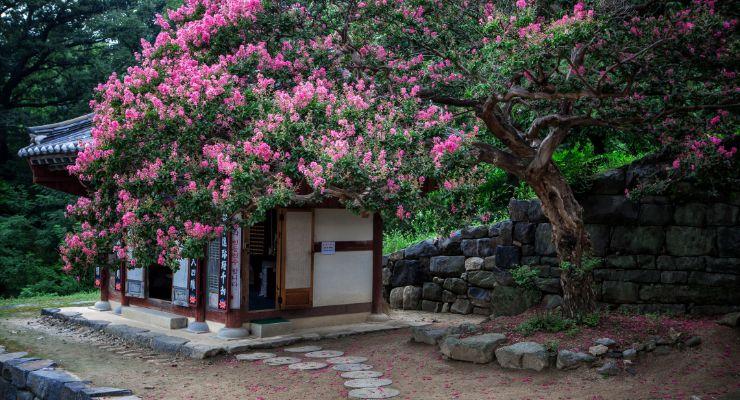
Desert willow (Chilopsis linearis)
Chilopsis linearis, commonly known as desert willow, is a unique and beautiful species of flowering plant that is native to the southwestern United States and northern Mexico. It is a member of the monotypic genus Chilopsis, which means it is the only species in its genus.
Desert willow can range from 1.5 to 8 meters in height and can have the general appearance of either a shrub or a small tree, depending on its growing conditions and the specific cultivar.
The deciduous leaves of the desert willow are distinctly similar to those of a regular willow tree, with an opposite arrangement and vibrant light green hue.
The tree is typically found in riparian mixed-deciduous woodlands of the Southwest, where it thrives in hot and dry climates. It is tolerant of drought and can survive in poor soil conditions, making it a great choice for xeriscape gardens.
Adding a splash of color to residential gardens, parks and streets where trees with purple flowers work very well, the desert willow is usually a great choice. This small-to-medium-size tree captivates with its large and eye-catching flowers which bloom in shades of pink, lavender, purple or white flowers during the late spring/summer months – providing an ideal destination for hummingbirds, bees & butterflies!
Not only does it provide aesthetic value but also requires minimal maintenance making this beautiful tree a great choice. Gardeners looking for a hardy, lovely tree that can flourish in hot and arid environments need to look no further than desert willow. This low-maintenance variety is the perfect choice for effortless gardening with stunning results.
The care of desert willow requires full sun or partial shade and soil that drains well[1]. It should be watered deeply every five to seven days for the first year, and established beautiful trees should be watered every two weeks in the summer and every month in the winter. The Desert willow is not a true willow, but a member of the catalpa family.
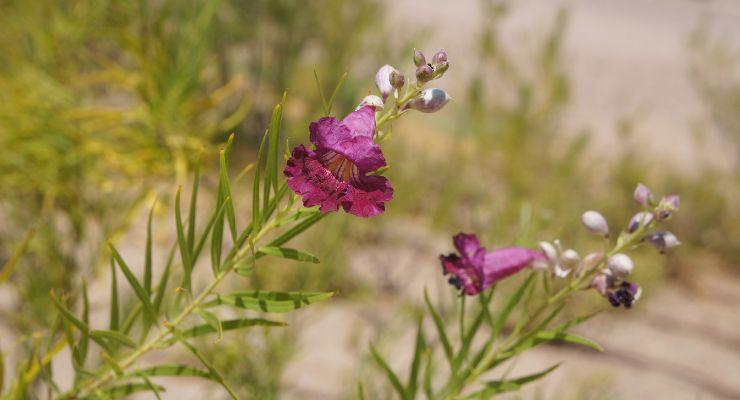
Purple lily magnolia (Magnolia liliiflora)
Magnolia liliiflora, commonly known as Purple Lily Magnolia, is a small tree native to southwest China. This deciduous tree puts on an impressive spring display with large, eye-catching pink flowers and purple blossoms. These flowers are a beautiful addition to any garden, and their citrus fragrance adds an extra layer of beauty to the tree. The flowers have 6 to 7 tepals, are goblet-like or lily-shaped, purple-red on the outer surface, white on the inside and have a citrus fragrance.
Purple Lily Magnolia is a deer resistant and easy to grow, it can be grown in full sun to partial shade and prefers organically rich, neutral to slightly acidic soils. With no significant insect or sickness concerns, this plant species is the ideal pick for gardeners at any aptitude level.
To ensure the health of your Magnolia liliiflora, it is essential to provide regular watering during its initial years. It is best to grow this shrub in consistently moist, slightly acidic soil with well-draining soil. Once established, the shrub is moderately tolerant of temporary dry conditions, but should be monitored during prolonged droughts as it can be killed by them.
Introducing the Purple Lily Magnolia to your garden is the perfect way to add captivating beauty and interest throughout all four seasons. This small tree boasts abundant pink-purple flowers in spring, followed by glossy leaves during summertime. What’s more? It’s incredibly easy to care for and will thrive in a variety of climates and soil types – making it an excellent choice for any outdoor space if you are after beautiful purple flowering trees.
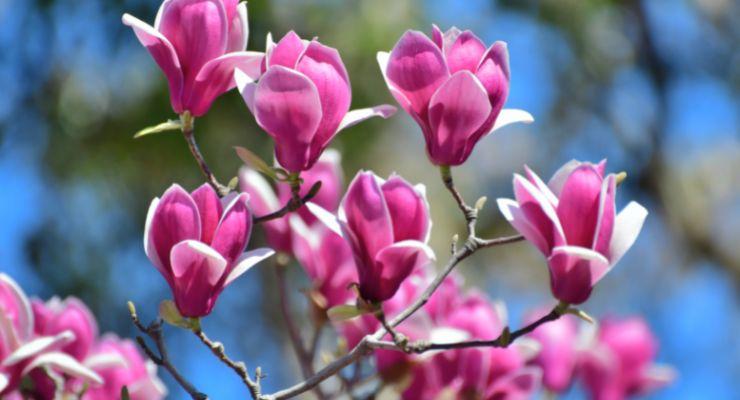
Chaste tree (Vitex agnus-castus)
The Chaste tree (Vitex agnus-castus) is a versatile and beautiful deciduous shrub or tree that can add a touch of elegance to any garden or landscape. Native to Europe and Asia, it is well-suited to warmer climates and thrives in full sun. However, it can also be grown in cooler climates with proper pruning.
The chaste tree can grow up to 10-15 feet tall and has distinctive grayish-green foliage with gray undersides. The tree is most well-known for its fragrant lilac-colored blooms that bloom in late summer to early fall.
This tree is also an excellent choice for a large shrub or small purple flowering tree in the smaller, modern suburban landscape.
The Chaste tree has gained the Royal Horticultural Society’s Award of Garden Merit, which is a testament to its excellence as a garden plant.
If you are seeking a stunning tree that is easy to maintain, the Chaste tree is the perfect choice for your garden. Its adaptable nature and striking flowers make it ideal for any climate or soil condition.
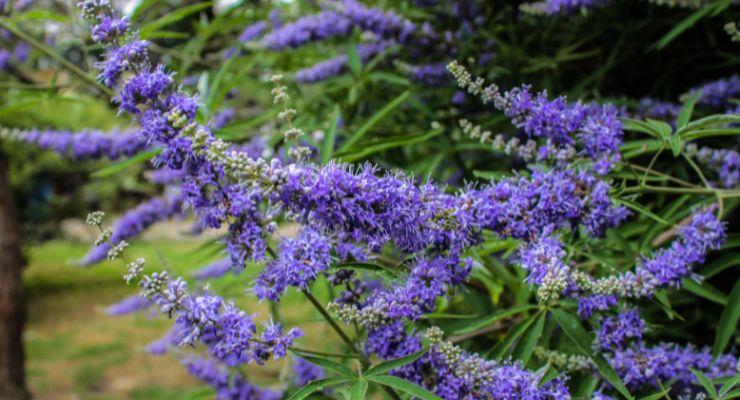
Eastern redbud tree (Cercis canadensis)
The Eastern Redbud tree (Cercis canadensis) is a large deciduous small tree that is native to eastern North America, from southern Michigan south to central Mexico, and east to New Jersey. It is hardy in USDA hardiness zones 6b – 9, and can thrive as far west as California and as far north as southern Ontario.
The Eastern Redbud is a prominent feature in many mixed forests and hedgerows, plus it’s often found adorning gardens as an aesthetically pleasing ornamental tree.
The Eastern Redbud typically grows 15-30 feet tall, with one to several picturesque, maroon-purple trunks and a wide, umbrella-like crown. In early spring, clusters of rose pink to light purple flowers mature and attract many pollinators including butterflies. The genus name Cercis comes from the Greek word for “weaver’s shuttle”, referring to the shape of the seed pods.
Eastern Redbud trees are known for their attractive foliage, showy flowers, and interesting bark. They are also valued for their drought tolerance and ability to thrive in poor soils.
The Eastern Redbud requires minimal care. It prefers full sun and moist, well-drained soil. To prevent moisture loss, apply mulch around your tree’s base – but make sure to keep it away from the trunk.
Eastern Redbud trees are the perfect way to liven up your landscaping, with their vibrant colors and year-round interest. Whether you want to plant a single tree as a statement piece in your garden or create an eye-catching hedgerow, Eastern Redbuds can be easily adapted for both small and large gardens alike. Trees with purple flowers will brighten up any garden.
They thrive in different soil types and light conditions – so no matter where you live or how much time you have to dedicate to gardening, these hardy trees will fit right into your outdoor space!
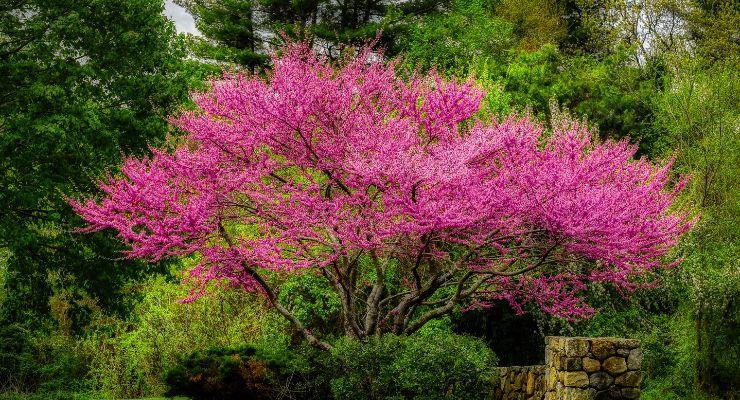
Jacaranda tree (Jacaranda mimosifolia)
Jacaranda mimosifolia, commonly known as the jacaranda tree or blue jacaranda, is a sub-tropical tree that is native to south-central South America. With its stunning and long-lasting violet blossoms, the tree is widely adored for ornamental landscaping.
It flourishes in various climates, particularly when planted in full sun (6 to 8 hours of sunlight) and given nutrient-rich soil with a slightly acidic pH level. In late spring or early summer, these remarkable blooms appear adding color and beauty to any landscape design.
The jacaranda tree can be propagated by seed or cuttings and should be pruned when young to form one central leader (main trunk) for strength and stability. The Jacaranda tree has the potential to thrive quickly in many different environments, but its growth rate is contingent on its climate.
In a tropical setting, this remarkable species can add up to ten feet of height each year for the first few years! In other areas with more temperate climates, it will still likely grow by three or four feet annually – an impressive feat nonetheless.
Jacaranda mimosifolia care includes providing consistent moisture throughout the year, often requiring additional watering during high heat or drought periods. Pruning not only gives the tree an attractive silhouette, but is also essential for its health and vitality. The tree is generally low maintenance and disease-free, but it’s important to keep an eye out for pests, such as aphids and scale insects.
Captivatingly enchanting, the Jacaranda tree is an ideal addition to any garden. Its exquisite blossoms add a touch of tropical sophistication and beauty that will take your breath away! Even among other trees with purple flowers, the Jacaranda will just shine.
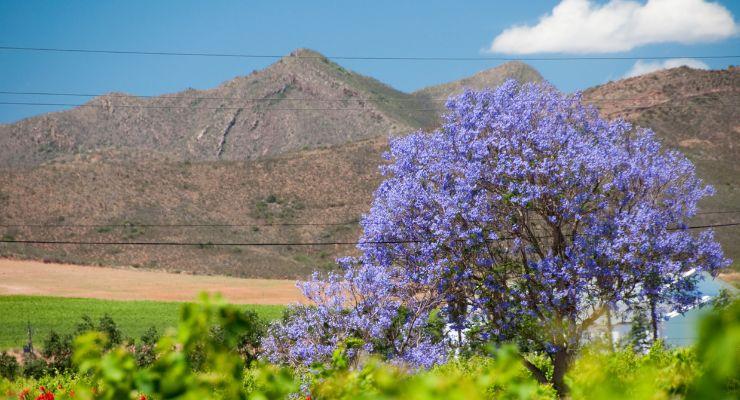
Purple orchid tree (Bauhinia purpurea)
The Purple Orchid Tree (Bauhinia purpurea) is a species of flowering plant in the family Fabaceae, native to the Indian subcontinent and Myanmar. Standing at a height of up to 17 feet and boasting rounded, bilobed leaves that measure 4-8 inches in length and width, the deciduous tree is one of medium size.
Bauhinia purpurea is a tree that is cultivated extensively around the world and across America’s coastal regions of Hawaii, California, Texas, and Florida. Its young leaves and flowers are both edible in nature as well as used to effectively treat various ailments with traditional remedies.
The Purple Orchid Tree blooms from September through November with five-inch-wide blossoms that are purple, pink, and white in color. These flowers are fragrant and create a vivid splash of color in the autumn landscape.
It is considered an invasive species in some regions, and not recommended for planting in natural areas.
When growing Purple Orchid Tree, should be grown in full sun on well-drained soil. It is very drought-tolerant and flowers best on dry soils. Normal watering means that soil should be kept evenly moist and watered regularly, as conditions require.
Overall, the Purple Orchid Tree is a beautiful, showy tree with a profusion of color and fragrance, making it a wonderful addition to any garden and a nice example of flowering trees with purple flowers.
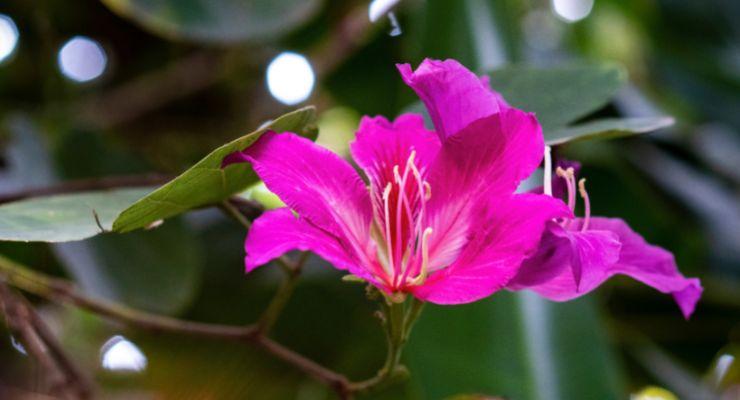
Purple Robe Locust Tree (Robinia pseudoacacia)
The purple robe locust (Robinia pseudoacacia ‘Purple Robe’) is a cultivar of the native black locust tree, known for its attractive, long clusters of purple-colored flowers that bloom in mid-to-late spring and have a pleasant fragrance.
It typically grows to 30-40 feet tall with an oval-upright habit and can reach a medium tree height of 30-50 feet. If you are searching for a rapid screen or shade trees, the Purple Robe Locust is an excellent choice as it grows two to three feet each year!
The Purple Robe Locust is the perfect addition to any low-maintenance landscaping, due to its impressive drought tolerance. But be sure to remove any unwanted root suckers as early as possible, since it can become highly invasive over time.
Another great feature of this tree is that it is loved by bees and beneficial insects, making it an ideal choice for any yard or garden.
Robinia pseudoacacia ‘Purple Robe’ is a fast-growing tree that is easy to care for. This plant thrives in direct sunlight, but can also tolerate some light shade. It adapts to most soil types and does not require regular fertilization. Until your tree is firmly rooted, make sure to water it regularly.
Pruning may be necessary to maintain its shape and size. This tree is a great option for those who want a beautiful, fast-growing tree that requires minimal maintenance.
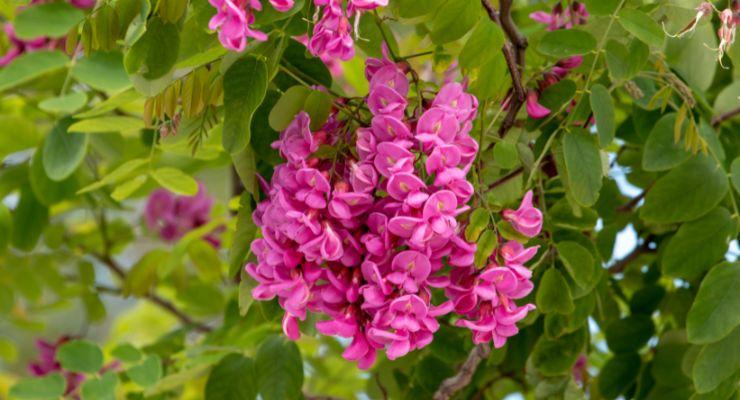
Texas mountain laurel (Dermatophyllum secundiflorum)
Texas mountain laurel (Dermatophyllum secundiflorum) is a species of flowering shrub or small tree in the family Fabaceae that is native to the Southwestern United States and Mexico.
This evergreen can come in the form of either a multi-trunked shrub or a small tree, spanning from just 2 to 3 feet tall all the way up to 30 feet. Its typical size upon maturity is 10 – 15 ft high. It has dark green foliage and produces purple blooms in the spring, which are a beautiful sight to see and are also highly fragrant.
One of the best features of Texas mountain laurel is that it is drought tolerant, making it a great option for xeriscaping or for use in areas that receive low rainfall. This versatile shrub or tree can be grown and trained to best fit your small space, either as an evergreen with a single stem or trimmed down and kept sizes small.
For optimum growth and care, the Texas mountain laurel should be positioned in a spot with direct sunlight exposure and watered occasionally during times of drought. While it is fairly adaptable to different soil types, this distinct species thrive in well-drained soils, making it a perfect choice for gardening.
Fertilizer is only needed if the soil is very poor. With tender care and attention, the Texas mountain laurel will blossom in any outdoor space, adding its captivating beauty and scent to your garden.
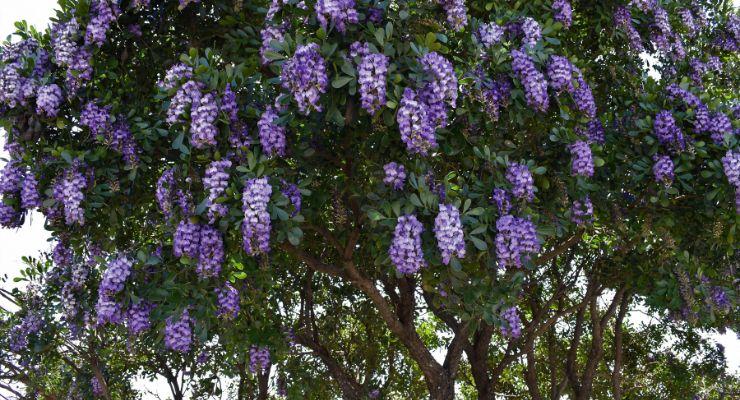
Empress Trees With Purple Flowers (paulownia tomentosa)
Empress tree (Paulownia tomentosa) is a deciduous hardwood tree in the family Paulowniaceae, native to central and western China. It was introduced from Asia in the 1840s as an ornamental and has also been cultivated in plantations for its specialty wood.
Soaring to heights of 30-60ft, the Empress tree is an incredibly fast-growing species known for its large leaves and beautiful flowers. Not only that, but it can withstand growing in poor soil conditions as well!
The Empress Tree is a beautiful example of a family of purple flowering trees, with large leaves and showy flowers. The flowers are usually purple to violet in color and bloom in late spring to early summer. The leaves are large and heart-shaped, and turn yellow in the fall before falling off. The majestic tree releases its large and featherweight seeds, allowing them to be carried away with the wind.
Although Empress Tree needs some attention, including regular watering and exposure to full sun or light shade, the rewards of planting it are abundant. Whether you grow it in the ground or a large container, be mindful that this plant can become uncontrollably invasive if not properly managed.
Be sure to routinely observe the Empress tree’s growth and regularly prune it for optimal health. With consistent attention, this majestic species can serve as an exquisite addition to any outdoor area.
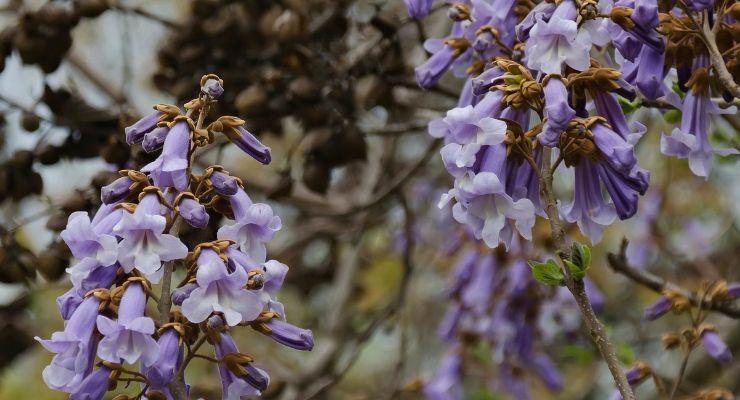
Purple Glory Tree (tibouchina urvilleana)
Tibouchina urvilleana, commonly known as the Purple Glory Tree, is a species of flowering plant in the family Melastomataceae, native to Brazil. It is a large, sprawling, tropical, evergreen shrub or small tree with glossy, dark green leaves and showy purple flowers that appear in terminal panicles.
It can grow up to 6-8 feet tall and wide in USDA zones 9 to 11. It has gained the Royal Horticultural Society’s Award of Garden Merit for its ornamental value.
The Purple Glory Tree is a low-maintenance plant, but it does require regular watering and prefers medium amounts of water with a deep soaking once a week during the growing season and more during an extremely hot spell.
Nurture your Purple Glory Tree with a balanced fertilizer every month during its growing season to maintain it healthily and stimulate blooming. After the tree has flowered, you may prune it to form and restrain its size.
The Purple Glory Tree can be grown in containers or in the ground. When grown in containers, it should be repotted every two years in a well-draining potting mix and fertilized regularly. When grown in the ground, it should be planted in well-drained soil in a sunny location.
To achieve the most vibrant and beautiful blooms, plant this flower in full sun. It can tolerate some shade if needed but will thrive when given plenty of direct sunlight.
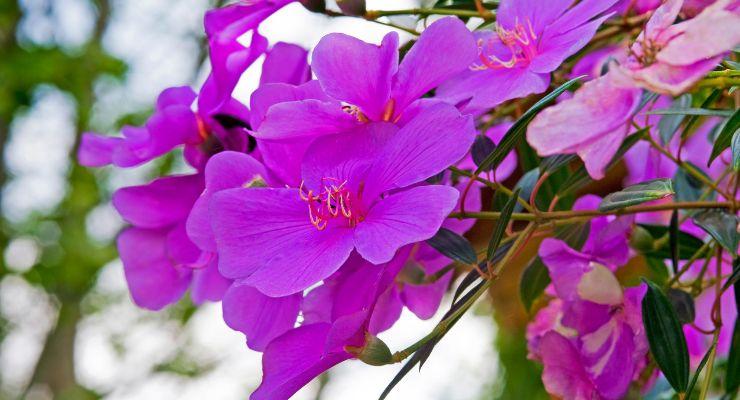
Hong Kong Orchid (bauhinia blakeana)
Bauhinia blakeana, commonly known as the Hong Kong orchid tree, is a hybrid leguminous tree that is a member of the Bauhinia genus. With its majestic purplish-red blooms reaching up to 10 – 15 centimeters in size, this tree is an awe-inspiring sight. Its flourishing period begins in early November and continues until the end of March.
The Hong Kong orchid tree, which is endemic to Hong Kong, was introduced to Taiwan in 1967. In 1984, it was chosen to be the city flower of Chiayi City in southwestern Taiwan.
The Hong Kong orchid tree can grow to be 20 to 40 feet in height and creates a rounded, spreading canopy composed of large, six to eight-inch-diameter leaves. It produces color from winter through spring with breathtaking reddish-purple flowers as large as 6 inches across.
To maintain the health of Bauhinia blakeana, it is essential to position it in an area where there is ample sunlight or partial shade.
Additionally, you should fertilize this tree three times per annum – during springtime, summer, and autumn – for maximum growth potential.
The Hong Kong orchid tree is the perfect choice for anyone who lives in an arid climate; not only is it incredibly beautiful, but it requires almost no water to maintain. Its blossoms are especially striking and thrive even in dry soil conditions – making this hardy tree ideal for any warm environment!
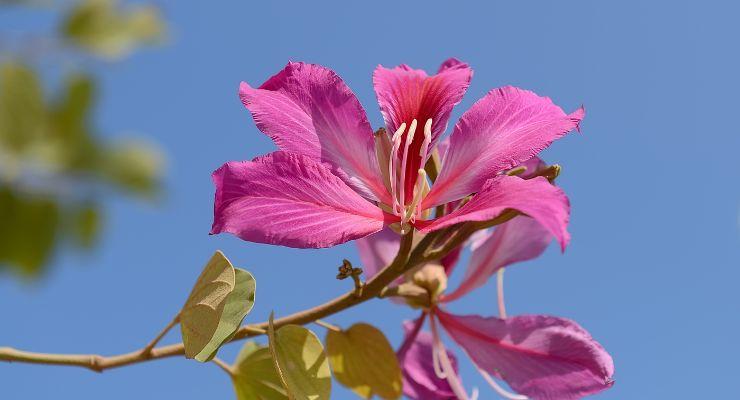
Purple Leaf Plum (prunus cerasifera)
Prunus cerasifera, commonly known as the purple leaf plum or cherry plum, is a popular ornamental tree due to its attractive foliage and showy spring flowers. This tree is known for its reddish-purple leaves that maintain their color throughout most of the year.
The most popular cultivar of Prunus cerasifera is ‘Atropurpurea’, which grows 15-25 feet tall and wide with a vase to a rounded shape. It prefers full sun for the best leaf color and is moderately drought-tolerant once established.
With the proper care, this tree is easy to maintain and thrive; however, it can be vulnerable to a range of pesky bugs such as borers, aphids, scales, leafhoppers, caterpillars tent, or Japanese beetles. Furthermore, spider mites could also affect its growth. To ensure its health and strength regular maintenance must take place to prevent these kinds of issues from happening.
Prunus cerasifera is a sight to behold in autumn with its vibrant, changing foliage. Yet, the beauty extends into early spring when this plant displays its dainty pink flowers and white blossoms. The tree also produces round edible reddish fruit, enhancing its aesthetic appeal. Overall, the purple leaf plum or cherry plum is a great choice for a small ornamental tree in the landscape.
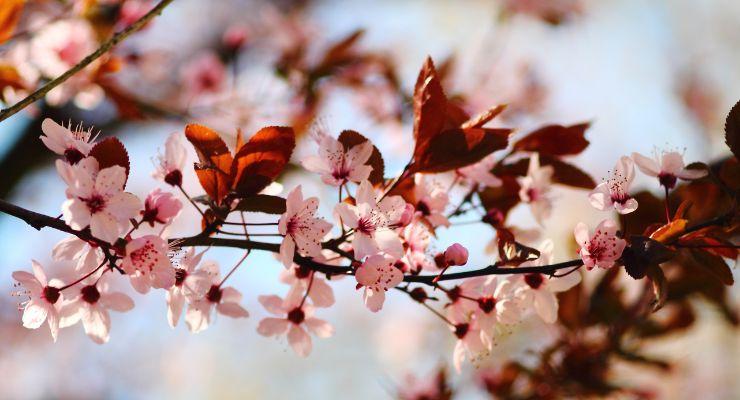
“Rio Salado” desert willow (Chilopsis linearis “Rio Salado”)
Chilopsis linearis ‘Rio Salado’ is a cultivar of the desert willow plant that is known for its fast growth and large, trumpet-shaped, burgundy red or purple flowers.
Stretching up to a staggering 14 feet in both height and width, this hardy cultivar can withstand arid conditions. Favoring light, well-draining soil that dries out between waterings, it is typically cultivated as an evergreen multi-stemmed shrub in temperate climates.
When it comes to caring, Chilopsis linearis ‘Rio Salado’ requires light, well-draining soil that dries out between waterings. It prefers full sun exposure and should be provided with plenty of water for the first year after planting.
It is a deciduous tree or shrub, meaning that it will lose its leaves during the fall and winter months.
To maintain your plant’s shape and vigor, it is advised to prune during the early spring months. Additionally, keep a lookout for any potential pests such as aphids that can disrupt the growth of this specific cultivar.
Rio Salado is a stunning and robust plant, perfect for gardens in hot and dry areas. It’s renowned for its captivating red flowers as well as its capacity to flourish during times of drought.
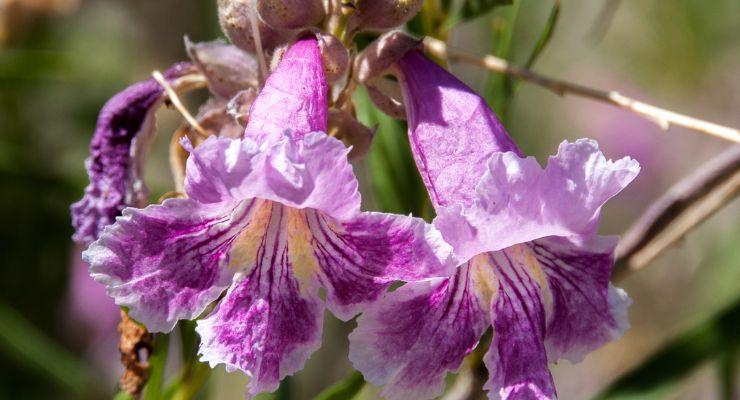
Conclusion
Trees with purple flowers in the garden can prove to be an eye-catching addition to any outdoor space. They have the potential to bring a pop of color to any dull or neglected plot and can transform it into a place of beauty. Ultimately, trees with purple flowers create an inviting atmosphere and offer respite from everyday life. Not only do they provide a sense of joy, but trees decorated with striking purple blossoms are also beneficial for wildlife, as they not only serve as habitats to many species but additionally create appealing landscape views.

